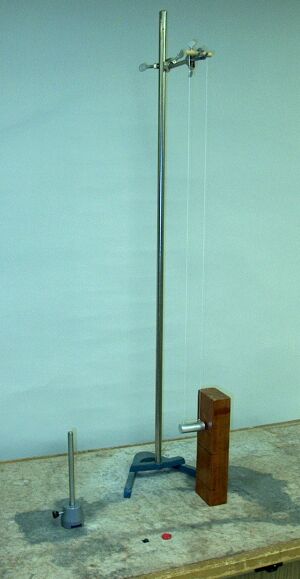

The aluminum bob has fixed to one end (the end next to the block in the photograph) a rubber foot. Pull the bob back to the upright metal rod, and then release it. When the bob strikes the block of wood, the block immediately falls. Now place a piece of modeling clay over the rubber foot. (There is a piece already in the right shape for this.) Now when you pull the bob back to the rod and release it, when it strikes the block, the block teeters, but does not fall.
The pendulum shown above is an aluminum cylinder that has an eye near each end, suspended by a string that runs through both eyes and is attached to a dowel clamped to a stand. The end of the cylinder that faces the wooden block has a rubber foot attached to it. Collision of this end of the pendulum bob with the block of wood is mostly elastic; kinetic energy is transferred from the pendulum bob to the block with little loss, and the momentum transfer is essentially that of an elastic collision. The pendulum is arranged so that when you pull the bob to the rod at left and then release it, when it strikes the wood block it imparts just enough kinetic energy to the block that it falls. If you place a piece of clay over the end of the bob, pull it back to the rod and release it, now when it strikes the block, some of the kinetic energy of the pendulum bob is lost in the permanent deformation of the clay – the collision is now inelastic – and the block now merely teeters instead of falling.